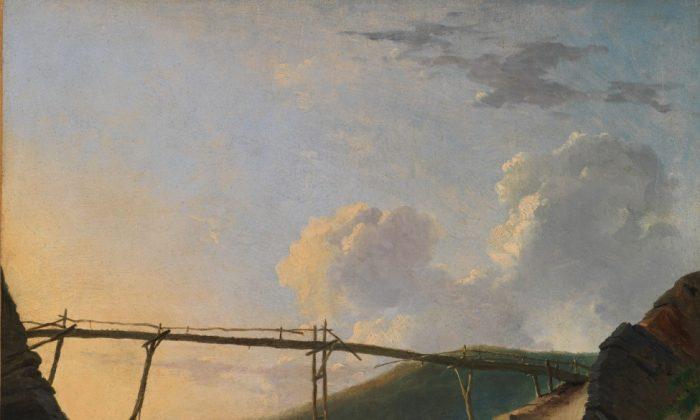NEW YORK—The 50 French paintings from the Wheelock Whitney collection, recently unveiled at the Met, provide a valuable insight into the process of producing a traditional landscape painting in oil. Many of the paintings are studies of the landscape, sky, and architecture done en plein air.
The collection is made up of 50 small-size paintings by relatively obscure artists. Many of them are unsigned and were not originally meant to be seen by the public.
Because the fundamentals of Western art emphasize capturing the likeness of the subject matter, it has been crucial for painters in the classical Western tradition to observe and evoke the natural environment. While painting outdoors has long been done, it became popular in the mid-1800s as portable easels and later tube paints were introduced.
This small collection features works produced by northern European artists between the 1780s and the 1840s. During this period after the French revolution and before the abdication of the last king, many French artists were working and traveling in Italy and abroad.
When New York collector Wheelock Whitney assembled this group between 1972 and 2002, he did not aim to form a collection representative of a particular style, place, or period, but selected works based on their quality. What he ended up with was a collection with skillfully done but never-before-seen oil drawings and studies.
Many of them were passed down in the painter’s families and were seen by the public for the very first time only in 2003. The current exhibit at the Metropolitan Museum of Art celebrates the 10th anniversary of this acquisition.
Nature Paintings
As a modern viewer, one cannot help but notice in this collection a variety of styles. On the one end of the spectrum, many of these small paintings are rendered with extraordinary detail, and visible brushstrokes are minimal. On the other end, some are done with large and painterly strokes, bordering on what we may consider impressionist style today.
Yet it is important to note that many of the pieces in the collection are sketches done in nature, meant to capture a moment in time so that the artist may practice rendering clouds, foliage, or atmosphere, or to sketch out a composition for use in a final piece.
These artists worked a century before impressionism was considered a style. Unlike impressionism, in which the painter tries to suggest transient light and the movement of subjects over a period of time, these studies are meant to capture a single moment in as much detail as possible or to study the tonal elements of a composition or the structure or texture of objects.
The plein air painter would carry his easel and paints into the field, scout out a pleasing perspective, set up his paints, and begin composing his image. Since canvases tend to be large and unwieldy, it was customary to use paper and then lay the painting down on canvas.
The skill it takes to simultaneously mix colors and hues, compose, and juxtapose compositional elements against the ticking clock of a setting sun or shifting light is something to marvel at.
The Collection
The collection features several works by Simon Denis (1755–1812), a Flemish painter about whom little is known. He was considered one of the first painters to do oil-on-paper sketches outdoors, according to his biography on the J. Paul Getty Museum website.
After he moved to Rome from Paris, he produced hundreds of paintings, taking nature as his teacher. His paintings show an intuitive understanding of atmosphere. In an 8-by-10-inch study of clouds, he simply and deftly executed layers of voluminous clouds, and with two dashes of pink peeking through them, reveals that the time was early evening, as the sun had almost disappeared into the horizon.
A sketch, oil on paper, by German-born Franz Ludwig Catel served as a preliminary study for a final painting titled “View From Virgil’s Tomb Over the City of Naples With Castel Sant'Elmo.”
In the sketch on location of Virgil’s tomb in Naples, Franz focuses detail on the far-off buildings that can be seen through a gap in steep rock cliffs. The cliffs themselves contain little detail, and the foliage on top of them was loosely scrubbed in. It is clear from the final painting that the artist’s intention with the sketch was to make an accurate representation of the buildings in view.















Friends Read Free